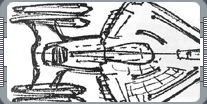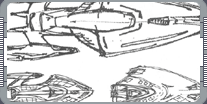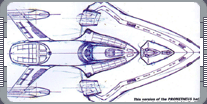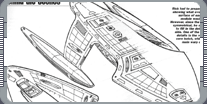
Designing the Prometheus - By Rick Sternbach
The USS Prometheus NX-74913 was supposed to represent the state of the art in Starfleet design. And,
because of its multi-vector assault mode, it had to split into three different ships, all of which had to
look suitably 'cool.'
 In the first four years that USS Voyager NCC-74656 was occupied with
escaping from Kazon warships, making hyperspatial jumps, and playing cat-and-mouse with the Borg, Starfleet
Command was equally busy developing an experimental starship with some very special capabilities. The
USS Prometheus NX-74913 was created for the Star Trek
Voyager episode 'Message in a Bottle,' in which the Doctor's holomatrix was transmitted tens of thousands of
light years (via an alien com relay) in an attempt to send word about Voyager's plight. The Doctor was
deposited aboard the new ship, which we discovered could separate into many autonomous pieces in a swarming
tactic - multi-vector assault mode. The script originally called for Prometheus to divide into five parts,
and the first doodles and computer shape sketches attempted to fit them all together (and take them apart)
with the requirement that the ship look good in both conditions, something that for various reasons was not
totally realized with the USS Enterprise NCC-1701-D's battle
section. After some early trials with the standard saucer and nacelle parts, I settled on a more streamlined
style as an evolution of Voyager's lengthened nose and wing-like pylons.
In the first four years that USS Voyager NCC-74656 was occupied with
escaping from Kazon warships, making hyperspatial jumps, and playing cat-and-mouse with the Borg, Starfleet
Command was equally busy developing an experimental starship with some very special capabilities. The
USS Prometheus NX-74913 was created for the Star Trek
Voyager episode 'Message in a Bottle,' in which the Doctor's holomatrix was transmitted tens of thousands of
light years (via an alien com relay) in an attempt to send word about Voyager's plight. The Doctor was
deposited aboard the new ship, which we discovered could separate into many autonomous pieces in a swarming
tactic - multi-vector assault mode. The script originally called for Prometheus to divide into five parts,
and the first doodles and computer shape sketches attempted to fit them all together (and take them apart)
with the requirement that the ship look good in both conditions, something that for various reasons was not
totally realized with the USS Enterprise NCC-1701-D's battle
section. After some early trials with the standard saucer and nacelle parts, I settled on a more streamlined
style as an evolution of Voyager's lengthened nose and wing-like pylons.
 The aft body that is normally the engineering hull in a starship could be split easily in two horizontally,
each section sporting two warp nacelles. In the sketches they would be called (strangely enough) Upper Warp
Hull (UWH) and Lower Warp Hull (LWH). This immediately required Prometheus to have two separate warp cores,
and more likely five matter-antimatter reactors if all parts had to do combat at warp. We knew that even
small shuttle craft have warp engines, so the small attack ships would be no problem, but could small groups
of coils drive the big forward hull? Would they need to be hidden to fool the bad guys? Doodles and computer
sketches continued and discussions began with Foundation Imaging, as they would do the final CGI model and
animation. One of the first 'close' blue-pencil drawings presented a dart-shaped main hull with slight
winglets, plus upper and lower embedded attack craft. Many of the usual Starfleet details were penciled in;
impulse engines, phasers, nav deflector, RCS thrusters, tractor beam emitters, and so on. I kept a list of
these handy, so - theoretically nothing was left off. It slowly dawned on me that everyone of the five ships
would need most of the same parts, which would make for a very complicated vehicle. Fortunately, we all got
a reprieve when the producers reduced the number of ships to three, citing the possibility that a swarm of
The aft body that is normally the engineering hull in a starship could be split easily in two horizontally,
each section sporting two warp nacelles. In the sketches they would be called (strangely enough) Upper Warp
Hull (UWH) and Lower Warp Hull (LWH). This immediately required Prometheus to have two separate warp cores,
and more likely five matter-antimatter reactors if all parts had to do combat at warp. We knew that even
small shuttle craft have warp engines, so the small attack ships would be no problem, but could small groups
of coils drive the big forward hull? Would they need to be hidden to fool the bad guys? Doodles and computer
sketches continued and discussions began with Foundation Imaging, as they would do the final CGI model and
animation. One of the first 'close' blue-pencil drawings presented a dart-shaped main hull with slight
winglets, plus upper and lower embedded attack craft. Many of the usual Starfleet details were penciled in;
impulse engines, phasers, nav deflector, RCS thrusters, tractor beam emitters, and so on. I kept a list of
these handy, so - theoretically nothing was left off. It slowly dawned on me that everyone of the five ships
would need most of the same parts, which would make for a very complicated vehicle. Fortunately, we all got
a reprieve when the producers reduced the number of ships to three, citing the possibility that a swarm of
 five might be a bit unwieldy and not look right on screen. Sketching resumed, primarily on the main hull, to
remove the two little attack darts and add a pair of warp nacelles. A Voyager-style shuttle bay door gave way
to an USS Enterprise NCC-1701 (refit) set of fan doors. A
comparison chart was developed to show the relationship between Prometheus and Voyager, not that the two
would ever appear in the same shot, but to help the producers visualize the ship and establish scale for the
paint scheme, windows, and other plant-on parts. Prometheus would come in at roughly 1,360 feet (414 meters)
in length, compared to Voyager's 1,130 feet (344 meters).
five might be a bit unwieldy and not look right on screen. Sketching resumed, primarily on the main hull, to
remove the two little attack darts and add a pair of warp nacelles. A Voyager-style shuttle bay door gave way
to an USS Enterprise NCC-1701 (refit) set of fan doors. A
comparison chart was developed to show the relationship between Prometheus and Voyager, not that the two
would ever appear in the same shot, but to help the producers visualize the ship and establish scale for the
paint scheme, windows, and other plant-on parts. Prometheus would come in at roughly 1,360 feet (414 meters)
in length, compared to Voyager's 1,130 feet (344 meters).
The next round of drawings refined the major shapes, and included a starboard elevation cutaway, which we
typically redrew in Adobe Illustrator to create the bridge engineering cutaway graphic. Prometheus worked out
to 15 decks, and we populated the ship outline with lots of standard cut-and-paste elements like corridors,
shuttlecraft, tanks, sensors, and turbolifts. Of course, many bits came in triplicate, like the computer
cores. Outside, the nacelles and pylons were styled to reflect some of the look of the
USS Enterprise NCC-1701-E, developed about the same time.
Unlike the Enterprise-E, the final pylons were swept forward, similar to today's sleek X-29 and Su-37 jet
aircraft, then given plasma transfer conduits and shield grids. At one point the pylons were flat and fit
 together in a stacked configuration, but I decided to angle them again as in the computer sketches.
Separating the nacelles gave the ship a bit more 'air' and the impulse exhaust a clear path backward!
together in a stacked configuration, but I decided to angle them again as in the computer sketches.
Separating the nacelles gave the ship a bit more 'air' and the impulse exhaust a clear path backward!
Armed with orders to proceed from visual effects, I made a series of perspective drawings, including the
familiar three-quarter front view, explaining all of the surface details of the combined ship. The phaser
strips were given an updated look with tapered ends, the lifeboat hatches became elongated hexagons to imply
a similar shape of lifeboat beneath, and the bridge dome got an armored top. Thinner sensor strips and new
pop-up photon torpedo launchers were added. The only area I wasn't completely sure of in three dimensions
was the trailing surface of the main hull, where the impulse engines attached and where the warp hulls (with
their own impulse vents) blended together with it. I had no doubt that Foundation would make it all work,
since they were able to push and pull polygons about to make just the right shapes. Similar curve-blending
questions in the same areas were solved by Tony Meininger on the Voyager miniature and by ILM on the
Enterprise-E, where hands-on sculpting revealed all.
 Eventually all of the exposed surfaces of the separated ships were drawn up for the CGI modelers, taking into
account shield grids, passageways with sealable connectors, bridge modules, and docking clamps. In the split
warp hull, a unique shared warp core could be divided and sealed off for the multi-vector mode, giving each
half its own core - only the upper half had the shuttlebay, however. The main hull was equipped with an
enlarged deck 1 containing the bridge, two lifeboats, and a housing for one of two mini-warp nacelles. Visual
effects wanted to see some articulation, so those nacelles extended out on swing arms. The arms also
contained the plasma conduits from a warp core somewhere deep in the hull. The dorsal nacelle extended up
from its housing; the ventral one dropped down into the space previously occupied by the LWH and the UWH.
With the 'engineering' of the last parts now worked out, I could relax and call the design finished.
Eventually all of the exposed surfaces of the separated ships were drawn up for the CGI modelers, taking into
account shield grids, passageways with sealable connectors, bridge modules, and docking clamps. In the split
warp hull, a unique shared warp core could be divided and sealed off for the multi-vector mode, giving each
half its own core - only the upper half had the shuttlebay, however. The main hull was equipped with an
enlarged deck 1 containing the bridge, two lifeboats, and a housing for one of two mini-warp nacelles. Visual
effects wanted to see some articulation, so those nacelles extended out on swing arms. The arms also
contained the plasma conduits from a warp core somewhere deep in the hull. The dorsal nacelle extended up
from its housing; the ventral one dropped down into the space previously occupied by the LWH and the UWH.
With the 'engineering' of the last parts now worked out, I could relax and call the design finished.
 Foundation Imaging regulars Mojo and Brandon MacDougall were provided with the sketches and orthographic
views necessary to build the CG version of the ship, with occasional notes and clarifications traded by fax.
Detail color swatches were pretty much standard Starfleet for the period, though the hull was spec'ed as a
lighter blue-gray than Voyager.
Foundation Imaging regulars Mojo and Brandon MacDougall were provided with the sketches and orthographic
views necessary to build the CG version of the ship, with occasional notes and clarifications traded by fax.
Detail color swatches were pretty much standard Starfleet for the period, though the hull was spec'ed as a
lighter blue-gray than Voyager.
As Prometheus was experimental, the NX-59650 registration number was added, down from a possible 74913,
perhaps to say that the development project had been in place quite some time before Voyager NCC-74656.
Start to finish, this was one of the fastest-looking ships in Starfleet, one of the most fun to design, and,
maybe one day, we might just learn if her class went into service in the 24th century.
|
|
"DESIGNING THE PROMETHEUS-CLASS" - MARCH 2003 ISSUE 45 STAR TREK: THE MAGAZINE COPYRIGHT OF PARAMOUNT PICTURES.
|